The second US Tank Destroyer
The M3 Gun Motor Carriage (GMC) was an early tank destroyer designed to carry the 75 mm M1897A4 gun, converted from the regular White M3 Half Track by the Autocar Company. It was produced for a limited time, until better solutions were devised. But it was not however seen as a stopgap or interim, contrary to its related cousin, the M6 GMC. The latter married a Dodge WC 55 multirole transport (3/4ton 4x4 Dodge), with a 37 mm 1940 ordnance 1.46 in M3 gun, mounted in the rear flatbed. Nicknamed the "FARGO" after the company which made the conversion. Over 5,300 were so converted in record time, at cheap cost (4,265 $ apiece), filling the ranks of the newly created US Tank Destroyer Batallions, engaged in North Africa from December 1942.The The M3 served in the Philippines Campaign first in January 1942, with the Provisional Field Artillery Brigade, mixing antitank and support roles. Thosed engaged later in North Africa by late 1942 in tank destroyer battalions as first intended had mixed results. They were ineffective at Kasserine Pass but successful at El Guettar. They also took part nin the Allied invasion of Sicily, slowely replaced by the M10 tank destroyer during the campaign of Italy. Of the total of 2,203 modified until April, 1,361 of those not lost in combat were converted back as regular M3A1 half-tracks in 1943.
The M3 GMC however soldiered on in the Pacific, better suited to deal with the generally weak Japanese Tanks. They distinguished themselves at the Battle of Saipan and other engagements like Peleliu right until Okinawa, dealing without issue with the Type 95 Ha-Go and Type 97 Chi-Ha.
Development
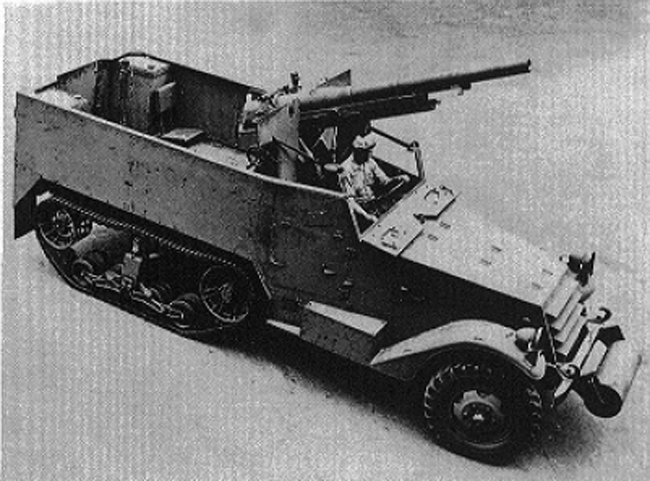
T73 prototype, with the original M2A1 shield
This went a long way. Tank Destroyers units were a vital part of the tank warfare doctrine developed from 1937. It'w only with the start of WW2 and the decisive use of armored vehicles on both sides during the French campaign of 1940 that the US Army believed to have nailed the effectiveness of the German campaign against the allies. In particular it was stressed the use of self propelled artillery by the Germans, the STUG was the most famous, but there was already the Panzerjäger-I and support vehicles such as the siG 33 Bison, also based on the obsolete Panzer I chassis. No such vehicle was in US inventory at the time.
At the same time armour thickness of French and German vehicles were estimated for prewar calibers, so it was decided already to shift from the 37 mm caliber, considered average, to the more potent 75 mm caliber. The idea emerged soon that to carrier a larger, heavier gun, a sturdier vehicle was needed. Such ordnance existed, this was the M1897A4, a long derivative of the French legendary Schneider '75' (3 in) produced in very large quantities before and during WWI and also adopted by the US ordnance in 1917. The Army indeed had many M1897A5 guns in the inventory. They were rapid-fire, but with average velocity, but it was though of using better ammunitions. More impoertantly, it was available in quantities at least equivalent to the 37mm and so well adequate to launch a mass-production.
From this, it was decided, after some debate, that a good self-propelled gun could be at an advantage on rough terrain with this heavy load, the White M3 Half-track, just coming into production. It was les costly than a fully tracked vehicle (chassis of which were too precious as tanks for the moment), with good overall mobility and minimal protection for the crew. The marriage made between the gun and the M3 chassis was initially known and tested at Aberdeen as the T12. Soon however it was recoignese the gun crew was not well protected, especially frontally, and it was decided to adopt notably the gun shield used on the M2A3 carriage for the M1897A4.
The M1897A5 gun was placed at first in a welded box riveted to the chassis of the T12, behind the driver's compartment. It was accepted as such by the Army on 31 October 1941. Eventually after many tests performed that year, the new vehicle entered production, standardized as the "M3, Gun Motor Carriage". It was simplified as M3 GMC in ordnance. M2A3 gun shields were in short supply when an order was passed for 2,000 vehicles in late 1941. Therefore for production a brand new and specific gun shield was designed, giving birth to the only variant of the type, also representing the bulk of the production, the M3A1 GMC.
Production wise, the first batch of 36 T12s were used for testing, and 50 M3 GMC (August–September 1941) of pre-production were transported right away to the Philippines. They would saw heavy action. The remaining T12s were improved in many ways, until the end of the production. The instalation fo a mount raising the gun shield as well as the main gun, installation of the new M2A3 gun shield, and installation of an extra 0.5 in (12.7 mm) M2 coaxial Browning machine gun. But the latter was unwieldy to operate and later removed.
Final improvements led to the final prototype M3 sent to the Autocar Company which started the bulk of the production, which went on until early 1942, when the stock of M2A3 gun shields dried out, conducting to adopt the new M5 gun shield, giving birth (alng other minir improvements) to the new M3A1 standard. The latter constituted the largest part of the production, ceasing in April 1943. Total span was from february 1942 to that date, so fifteen months. The M3 was replaced by the M10 GMC "Wolverine" in late 1942.
Design of the T12

Blueprint of the M3A1 GMC, with the M5 shield
Chassis: M3 Half Track
The M3 GMC was identical to the original White model, 20.46 feet (6.24 m) long, 7.29 feet (2.22 m) wide, 8.17 feet (2.49 m) high to the gun shield top for weighed 20,000 pounds (9.1 t) and with a Ground clearance of 11.2 in (280 mm). Its suspension combined semi-elliptical longitudal leaf springs for the directional wheels but also vertical volute springs for the tracks. For transmission it had a constant mesh gearbox.Propulsion at the front consisted in a White 160AX gasoline engine, with a 386 cubic inch (6,330 cc) capacity. It was 6-cylinder engine, with a compression ratio of 6.44:1. It was rated for 147 horsepower (110 kW), with a lot of torque and 14.7 hp per ton ratio. Range was limited to 150-mile (240 km) on road, less offroad, from its 60 US gal (230 l) main fuel tank, completed by two external jerrycans. Top speed was a moderate 47 mph (75 km/h) due to the tracks hight drag. The vehicle had the same armor, unchanged fromthe iriginal, and designed originally to partially protect the crew against small arms fire and shrapnels. The back, sides and front went from 0.25–0.625 in (6.4–15.9 mm). The top was unprotected and the M5 gun shield was 15 mm thick (0.55 in) as the M2A3.
Gun: The M1897A4
The M3 (M2A3 mount) could traverse 19° left and 21° right, elevate 29° and depress −10°. The M3A1 (M5 mount) could traverse 21° also but depress only −6.5°. The M1897A4 used an improved ammunition, tailored for that role, the M61 armor piercing (AP) round, able to penetrate up to 3 inches (76 mm) of armor at 1,000 yards (910 m). Muzzle velocity was 2000 feets/sec. or 610 m/sec, which was not brillant. 59 rounds were carried. The 19.9 lb AP (9.0 kg) total (13.93 lb or 6.32 kg for the projectile alone) could penetrate 2.7 in (69 mm), 2.4 in (61 mm), 2.2 in (56 mm), 1.9 in (48 mm) at 500, 1000, 1500 and 2000 yards respectively. Needless to say this was just equivalent to the frontal armor of most German Tanks in 1943.M3 GMC specifications | |
| Dimensions (L-w-H) | 6.24 x 2.22 x 2.49 m (20.46 x 7.29 x 2.49 ft) |
| Total weight, battle ready | 9.1 t (20,000 lb) |
| Crew | 5 (commander, driver, 1 gunner, 2 loaders) |
| Propulsion | White 160AX, 6,330 cc 6-cyl. 147 hp (110 kW), p/w 14.7 hp/ton |
| Top speed | 75 kph (47 mph) |
| Suspensions | Semi-ellipitical longitudal leaf spring + vertical volute springs |
| Range | 240 km (150 mi) |
| Armament | Main: 75 mm Gun M6, 2 x .30 in M1919 MG |
| Armor | 16 mm (0.63 in) maximum |
Active service
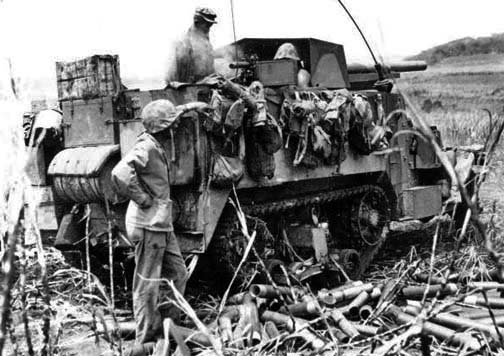
GMC in Tinian, 1944
The T12/M3 GMC was first engaged in the Philippines in 1941–42, with 50 shipped on convoys from September to December 1941. They were constituted into three battalions of the Provisional Field Artillery Brigade. They were put to good use against the Japanese during the first days of the invasion, but mostly to provide direct covering fire and more rarely in anti-tank support role. A few were lated captured but no photo exist of them in Japanese service.
By November 1942, M3 GMCs filled the first US destroyer battalions deployed in the North African Campaign. Each of these had 36 M3s and still four 37 mm M6 GMCs. They were designed to ambush tanks preferrebaly in wooden areas, and were not at eas in a desertic, rugged landcsape, taking crippling losses at the battles of Sidi Bou Zid and Kasserine Pass. Tactics were just not well adapated.
Patton however saw their potential and exprtstly deployed them on the path of the Afrika Korps at the Battle of El Guettar. They claimed 30 Panzer III/IV plus allegedly two Tiger tanks for 21 losses. Further batallions were deployed during Operation Husky, to be replced by the M10 tank destroyer and the remainder were either passed onto the British VIIIth army or converted in the field bacj as regular M3A1 for the infantry, 1,360 total.
The M3 GMC would soldier on however on the other side of planet: They were well liked by the U.S. Marines and used en masse in the the invasion of Saipan. Deadly again the Ha-Go and Chi-Ha thery decimated the Japanese 9th Tank Regiment. They were also landed at the Battle of Peleliu and took part much later in the Battle of Okinawa
British Forces were given many of these in north africa, although never officially on the Lend-Lease program. 170 vehicles were pressed in British Armoured Car Regiments, reconnaissance units of armored divisions, bringing antitank capabilities. They saw action already Tunisian Campaign with the Royal Dragoons. They soldiered on in Sicily, and then in Italy, and later France from Normandy, but between losses and better vehicles being provided, they were gradually retired. The Free French Army received M3s for training, before being replaced by M10 tank destroyers also in North Africa, 1943. Two were issued per squadron, but they were eight per regimental artillery battery. Many soldiered on until the last days of the war in the West and the Pacific.
Links/Books about the T12
Berndt, Thomas (1993). Standard Catalog of U.S. Military Vehicles. Iola, WI: Krause Publications.Berndt, Thomas (1994). American Tanks of World War II. Minnesota, MN: MBI Publishing Company.
Hogg, Ian V.; Weeks, John S. (1980). The Illustrated Encyclopedia of Military Vehicles. Englewood Cliffs, NJ: Prentice-Hall.
Hunnicutt, R. P. (2001) Half-Track: A History of American Semi-Tracked Vehicles. Navato, CA: Presidio Press.
Mesko, Jim (1996). M3 Half-tracks in Action. Carrollton, TX: Squadron/Signal Publications.
Ness, Leland S. (2002). Jane's World War II Tanks and Fighting Vehicles. New York, NY: HarperCollins.
Zaloga, Steven J. (1994). M3 Infantry Half-track 1940–1973, Oxford: Osprey Publications.
Illustrations
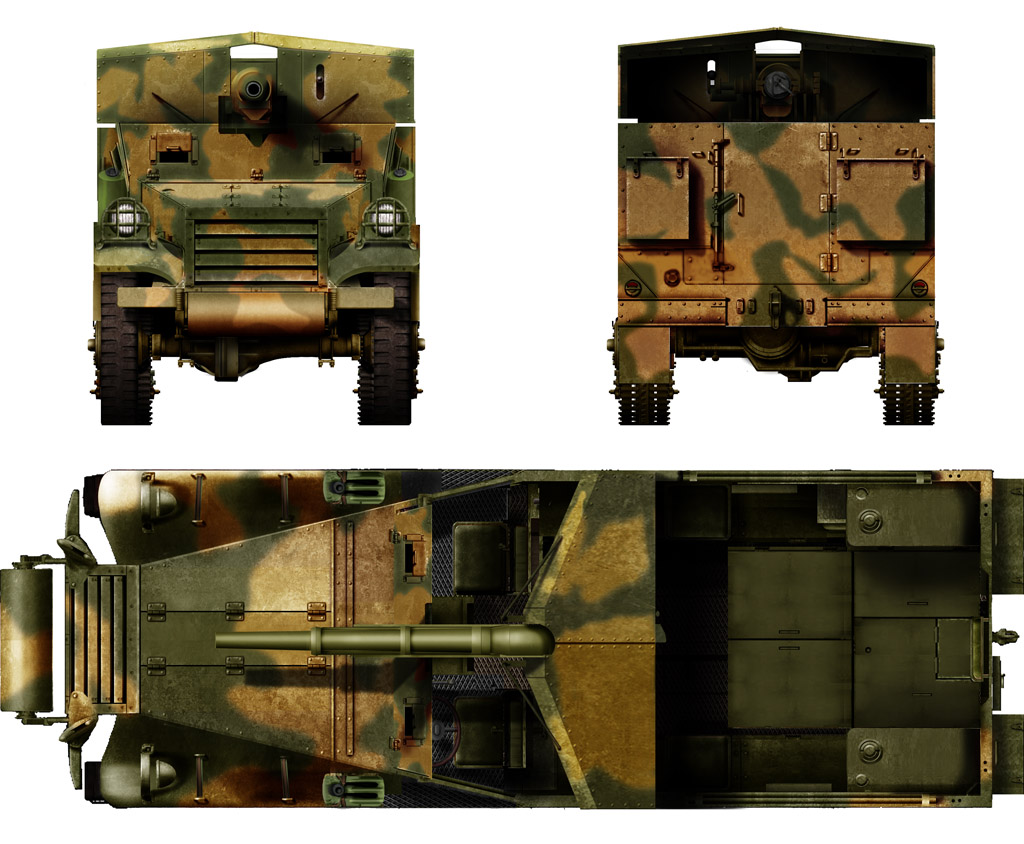
3 views of the vehicle
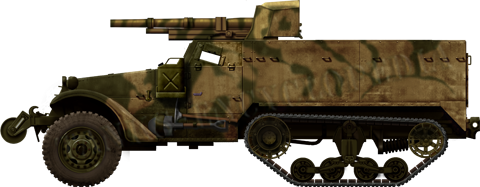
M3 75 mm GMC in North Africa, US first division, Tunisia, june 1943.

GMC in Sicilia, 1943
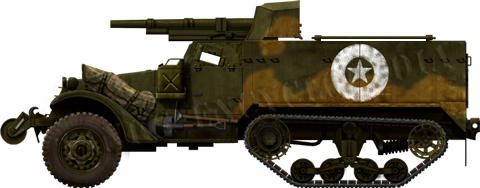
Another 1st US army (Big red One) GMC stationed in Sicilia, May 1943.
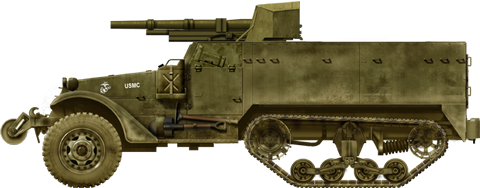
M3 GMC of the 3nd Div USMC at Bougainville, late 1943

T12 GMC in British service, Eight Army, Tunisia, may 1943.
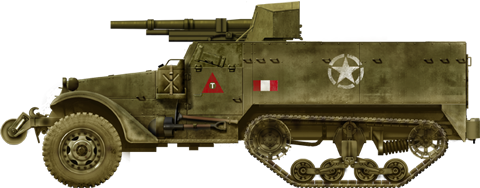
With the British Army in Italy
Photo gallery (T17)
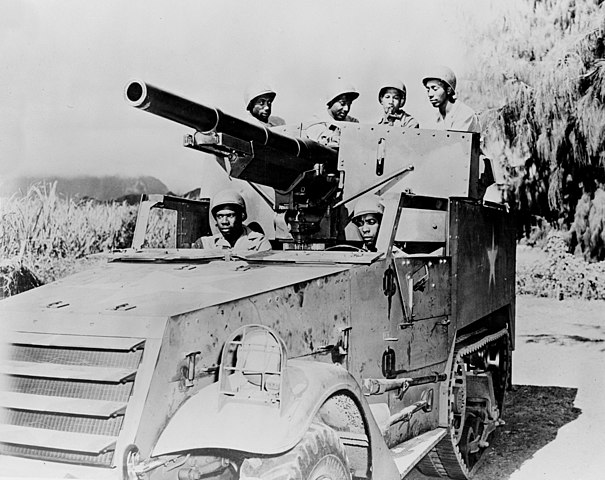
M3 GMC with a colored regiment in Italy
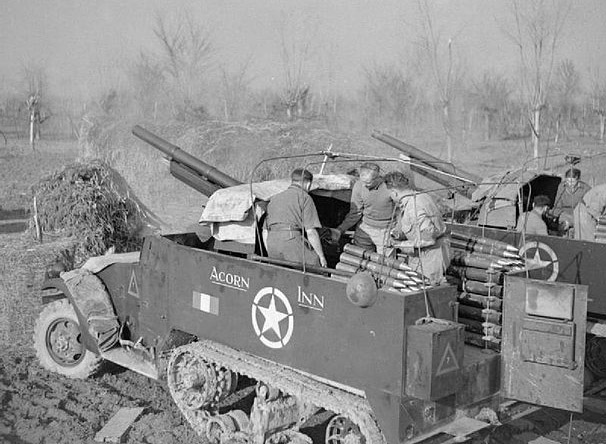
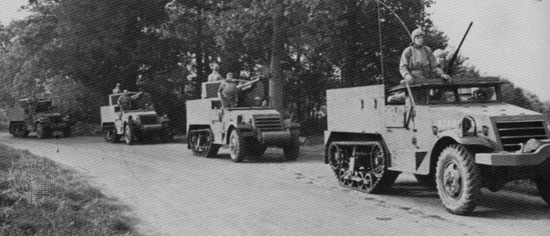
A column of M3 half tracks with the two GMC in the center
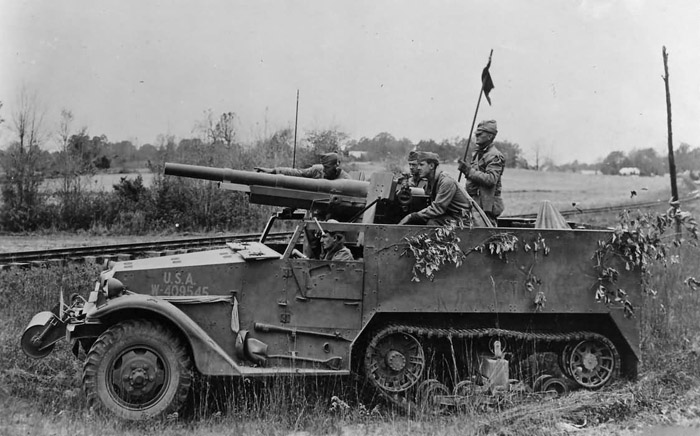
GMC T12 from B company of the 93rd Tank Destroyer Battalion during exercises held in November of 1941.
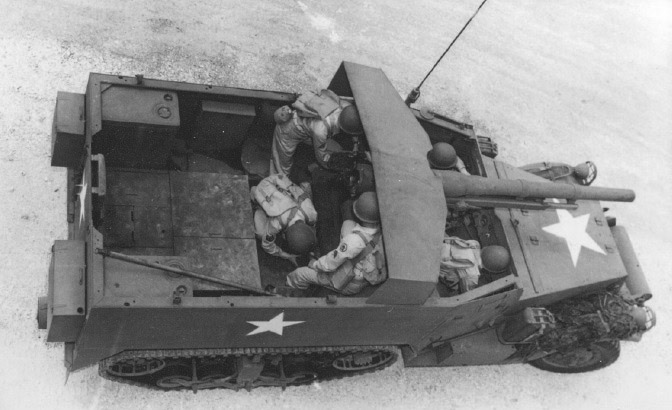
Top View
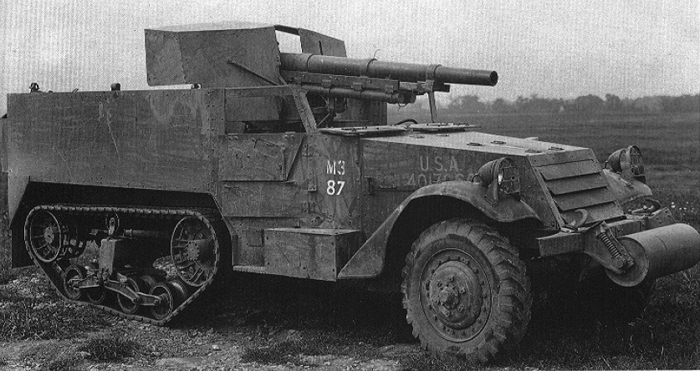
M3A1 GMC
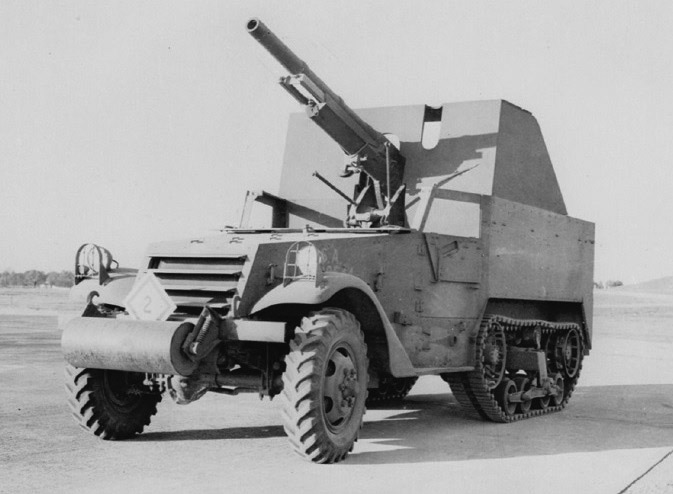
M3A1 with the M5 shield
Video

WW2 Tanks




























WW2 tanks posters

All Tiger tanks liveries.

Panther liveries and variants

WW2 Armour - All tanks











Tanks aces and single tanks series

Find more there

Museums, Movies, Books & Games
The Tanks and Armor in pop culture
Tanks and armored vehicles in general are only really grasped when seen first person: The mass, the scale, it's all there. Explore also the way tanks were covered in the movie industry, in books and in video games.Movies:
Best tanks movie on warhistoryonline.com
On imdb.com
On bestsimilar.com/
miltours.com
liveabout.com/
watchmojo.com
Video Games:
pcgamesn.com
historyhit.com
levvvel.com
vg247.com/best-tank-games
mmobomb.com/
alienwarearena.com

